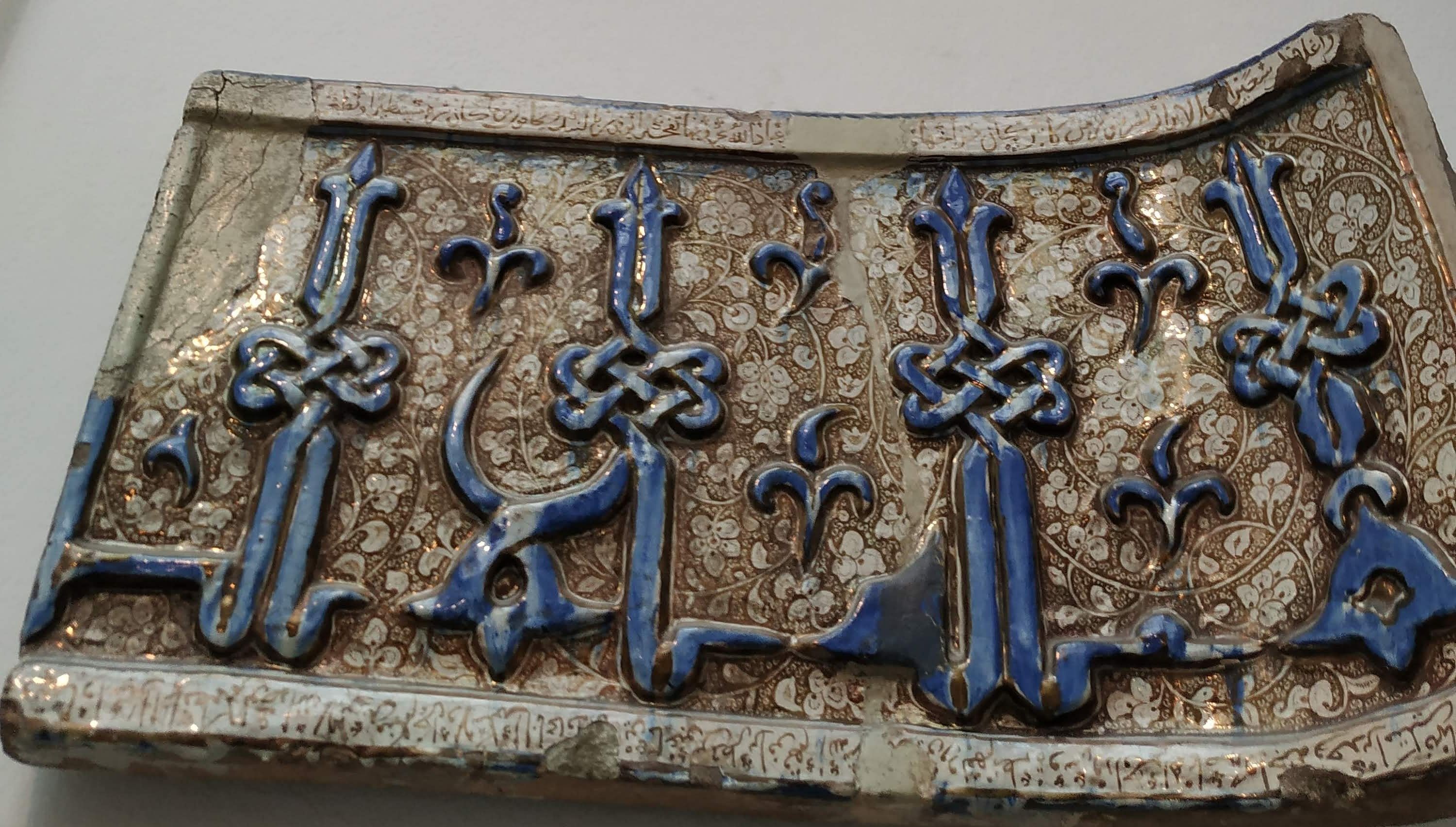
A tile on display at the Islamic Art Museum, Berlin.
PHOTO BY AUTHOR
In the 8th century, Umayyad caliph al-Walid ibn Yazid built a splendid desert palace in Mshatta, about 30 kilometres south of today’s Amman, the Jordan capital. But it remained incomplete after his assassination. Later, it was most probably damaged extensively during an earthquake. With its stone-carved ornamentation, this monument is considered one of the most important works of early Islamic architecture. In ruins now, its original site, a part of the beautifully worked façade, can still be seen at the Museum of Islamic Art in a wing of the famous Pergamon Museum of Berlin. Last month the museum was shut down till 2037 for major refurbishment.
A large part of the south facade of the palace was presented as a gift to the German emperor Wilhelm II by the Ottoman sultan Abdülhamid II and that’s how it landed in Berlin in 1903. Motifs from Coptic, Syrian, and Sasanian culture — the last Persian imperial dynasty before the Muslim conquest, can be seen on the façade that showcases the art of the Ancient Orient.
I was still dazed by the recreation of the road that once led to the Ishtar temple in Babylon in blue lapis lazuli on the ground floor of the Pergamon but decided to climb up the stairs to explore the Islamic Museum collection. A wise decision it was indeed. This museum is the only one of its kind in Germany, and the oldest in the West. Only the Museum of Islamic Art in Cairo is older. It has one of the most important collections with some of the world’s finest examples of Islamic art collected from nearly all regions of Islamic rule from a vast area stretching from Spain to India. The collection’s main focus, however, is on the Middle East, including, Egypt and Iran.
The Museum was opened in 1904 by art historian and museum curator Wilhelm von Bode (of today’s Bode Museum next door) who donated his extensive collection of carpets. It was an age when Western archaeologists and art historians were getting interested in the art treasures of the Near East. Later, the collection moved to the newly-built Pergamon Museum in 1932. It was closed during the Second World War for some years. Many more artefacts were added later and the collection displayed chronologically, allowing the visitor to follow the different stylistic phases of Islamic art and to develop a notion of the complex Islamic history and its artistic merits.
Today, Aleppo in Syria is more known as a war zone. But look at the repainted wooden panelling in the beautiful red room from Aleppo that belonged to a Christian businessman and it will take your breath away with the harmonious colour combinations and design. It reflects a long history of art and culture of the region to which Christians and Jews living in the Islamic world also contributed. As an illustration, the panel has Christian themes from the Old and New Testaments with the depiction of Mary with Child sitting alongside courtly scenes like those portrayed in Persian book illustrations. Belonging to the early 17th century, it is the
oldest surviving example from the Ottoman World.
The 13th-century ceramic prayer niches from Kashan (Iran) and Konya (Turkey) are equally stunning with their intricate craftsmanship. Carpets and tapestries are as integral to households and palaces in Europe as in the Near East. Europe’s cultural history is interwoven with this handicraft.
Many of these were produced in the Middle East. The carpet room displays old carpet samples which are painstakingly restored. A video shows how some are restored hair by hair, quite literally. After washing, which itself has to be scientifically done, they are dried, wrapped in moisture-proof material, and kept under a specific temperature to keep them dry, until they are taken out for the next display. In the permanent exhibition corner, you can see a huge carpet spreading across the wall from the Mughal era in India.
During this period, miniature paintings were highly developed in the country and they also figure in the calligraphy and painting section.
During the Second World War, heavy bombing damaged many of the textiles and carpets. Among them is a fragment of a 16th-century Persian carpet, the first work of art in the collection. Also, a highly prized item is a Caucasian dragon rug from the same century still showing burn marks.
Household objects like hookahs, wine caskets, jewellery cases are on display too each of which is decorated beautifully. Indeed you marvel at the aesthetics and craftsmanship that go centuries back, as much as the gigantic recreations in the other sections of the Pergamon.
Other museums like the Bode Museum, Neus Museum are all within easy reach clustered in the UNESCO-heritage ‘Museum Island’ in the heart of Berlin, a feast for connoisseurs indeed.